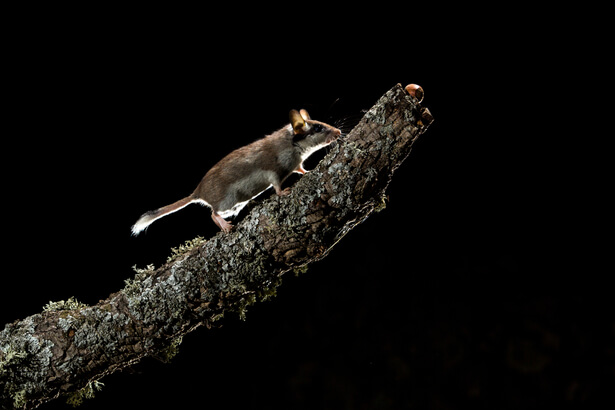The garden dormouse is a rodent that is not quite like the others, which tends to live relatively close to humans. And yes, we do not scare them any more than a tree sparrow and in addition they have perfectly understood how to take advantage of our presence. So let’s take our magnifying glass to discover together this little rodent with the plumed tail.
The dormouse (Eliomys quercinus) has a special ability: it adapts. Hedges, attics or even hollow trees (long live orchards!) are their favorites, but they also know how to run into abandoned mailboxes, holes in walls or even in under-roof insulation. The dormouse lives alongside us and in a way a little thanks to us, so let’s preserve it and learn more about this member of our ordinary biodiversity.
The garden dormouse, a truly adorable nocturnal rodent
A little ball of fur as cute as this always raises questions. With its 40 to 120 gwhich is not much, the dormouse can still measure from 10 to 17 cm.
Omnivore like us, the dormouse, animal with a strong carnivorous tendency (and a big preference for insects), is above all a opportunistic : he also knows how to take advantage of our presence, which allows him to survive in many situations… Our pets’ kibble is a little appetizing for him!
The home range of a dormouse is 150 m in diameter.so before chasing him away because he’s making a bit too much noise or you’re afraid of him (without reason, for your information) think carefully about his exit doors.
The black spots around his eyes are characteristic © FJAH
Peculiarities of the dormouse
Besides the fact that he’s cute – which is a peculiarity in itself and can make the difference between a species that we humans protect and one that we leave to its sad fate – The dormouse is also one of those animals that hibernate.
Once its spherical nest is built using moss and grass, the garden dormouse will line it with hair and/or feathers to spend the winter in warmth. In preparation for the cold season, it increases its fat mass up to 200 g or more, then will nestle in its nest and hibernate while waiting for the nice weather.
Drop in body temperature, deep sleep, almost no search for food, a few sporadic awakenings, slow heart rate and… a big risk to wake up from such a state, so we don’t disturb!
Another of its peculiarities lies in its movements: a dormouse practically never touches the ground and moves from support to support.
Protection status
The garden dormouse is present almost everywhere in France, although in different proportions, because the environment is not necessarily suitable.
It is classified as “near threatened” throughout the territory, but “critically endangered” in Brittany.
Threats to the dormouse
The numbers of dormice are overall in sharp decline over the last few decades, but it is locally that some collapses are spectacular. The overriding problem on the subject is the lack of reliable information on the why and how.
Habitat loss
As with so many animals, the disappearance of hedges, field trees, cavities of all kinds or even hollow trees are a plague for dormice. Without favorable environments it is useless to imagine that the dormice can survive or, even harder, reproduce.
Chemicals
Let them be made directly to destroy it because dormice can cause damage to insulation, or through their food When they consume insects that have themselves consumed pesticides, the chemicals are a real danger to all dormice.
Light pollution
The garden dormouse is a rodent mostly nocturnal which suggests that the increasing number of night lights has a direct influence on it. In some cases, such as when it resides in a hedge, this has little impact, but in others, such as when it is visible to its predators, This pollution can cause great harm to him.

The night is his kingdom © Agami Photo Agency
How to help dormice?
The dormouse enjoys a great deal of sympathy thanks to its small face, which does not mean that everyone knows it as well as you who have just read this article. Better understanding the biodiversity that surrounds us is one of the keys to its protection so don’t hesitate to pass on your knowledge about the dormouse whenever you have the opportunity.
The risk of destruction, that is to say of seeing its nest destroyed so that it stops “squatting” in human neighborhoods, is particularly high and can affect anyone. Don’t destroy them and do not move them, unless they pose a risk to the home (these rascals can sometimes lodge in electrical boxes…). In this case, you can catch it in a dormouse trap and release it into the wild, far from any habitation.
Finally, there is many local and national associations who work on mammals and who may have an interest in you reporting the presence of these little creatures, so don’t hesitate to let them know that they are present near you.
Article updated
consoGlobe also recommends…
Source: www.consoglobe.com


